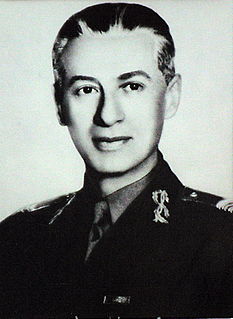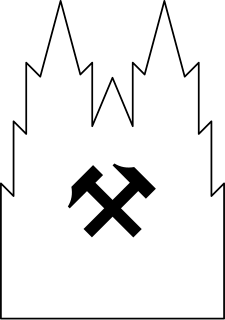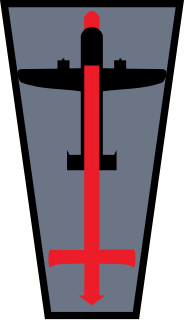
Constantin Sănătescu was a Romanian general and statesman who served as the 44th Prime Minister of Romania after the 23 August 1944 coup, through which Romania left the Axis Powers and joined the Allies.

Alfred Schlemm was a German General der Fallschirmtruppe in the Wehrmacht. His last command in World War II opposed the advance of the First Canadian Army through the Reichswald in February 1945.
The Soviet Union's 12th Army was a field army formed multiple times during the Russian Civil War and World War II.

Friedrich August Eberhard von Mackensen was a German general of the Wehrmacht during World War II who served as commander of the 1st Panzer Army and the 14th Army, and was a recipient of the Knight's Cross of the Iron Cross with Oak Leaves. Following the war, Mackensen stood trial for war crimes before a British military tribunal in Italy where he was convicted and sentenced to death, however the sentence was later commuted and Mackensen was released in 1952, and died in West Germany in 1969.

Carl Hilpert was a German general during World War II.
The XXVII Corps was an infantry corps in the German Army. It fought in several notable actions during World War II.
The 8th Army was a field army of the Soviet Red Army during the Second World War.

The 227th Infantry Division named "Rheinisch-Westfälische" was created on 26 August 1939 in Krefeld. The division was deployed for the last time in February 1945 in the Tuchola Forest.
The 19th Army was a field army of the Soviet Union's Red Army, formed in 1941 and active during the Second World War. The army was formed three times, although only two of its formations saw combat.

X. Fliegerkorps was a formation of the German Luftwaffe in World War II, which specialised in coastal operations. It was formed 2 October 1939, in Hamburg from the 10. Flieger-Division.

The United States Army Air Forces was the major land-based aerial warfare service component of the United States Army and de facto aerial warfare service branch of the United States during and immediately after World War II (1939/41–1945). It was created on 20 June 1941 as successor to the previous United States Army Air Corps and is the direct predecessor of the United States Air Force, today one of the six armed forces of the United States. The AAF was a component of the United States Army, which on 2 March 1942 was divided functionally by executive order into three autonomous forces: the Army Ground Forces, the Services of Supply, and the Army Air Forces. Each of these forces had a commanding general who reported directly to the Army Chief of Staff.

The United States Army Air Corps (USAAC) was the aerial warfare service component of the United States Army between 1926 and 1941. After World War I, as early aviation became an increasingly important part of modern warfare, a philosophical rift developed between more traditional ground-based army personnel and those who felt that aircraft were being underutilized and that air operations were being stifled for political reasons unrelated to their effectiveness. The USAAC was renamed from the earlier United States Army Air Service on 2 July 1926, and was part of the larger United States Army. The Air Corps became the United States Army Air Forces (USAAF) on 20 June 1941, giving it greater autonomy from the Army's middle-level command structure. During World War II, although not an administrative echelon, the Air Corps (AC) remained as one of the combat arms of the Army until 1947, when it was legally abolished by legislation establishing the Department of the Air Force.
The 3rd Guards Volnovakha Red Banner Order of Suvorov Motor Rifle Division was a division of the Soviet Army from 1957 to around 1992. It traced its history from the highly decorated 3rd Guards Rifle Division of World War II. 3rd Guards Rifle Division was formed from the 153rd Rifle Division.

The 1st Anti-Aircraft Division was an Air Defence formation of the British Army before and during the early years of World War II. It defended London during the Battle of Britain and The Blitz.
The 29th Rifle Division was an infantry division of the Red Army and later the Soviet Army.
The 49th Rifle Division was a Soviet Army infantry division, formed three times. First formed as a territorial division in 1931, the 49th Rifle Division's first formation became a regular division by 1939 and fought in the Winter War. For its actions during the war, it was awarded the Order of the Red Banner. However, the 49th Rifle Division was wiped out during the first ten days of Operation Barbarossa. Its second formation occurred in December 1941 and fought at Stalingrad, Kursk, the Vistula-Oder Offensive and the Battle of Berlin. The second formation was disbanded in 1946. The division was reformed in 1955 by renaming the 295th Rifle Division and became the 49th Motor Rifle Division in 1957.
The 11th Mechanized Corps was a mechanized corps of the Red Army, formed twice. The corps was first formed as one of the original two Red Army mechanized corps from the 11th Rifle Division in Leningrad. In 1934 it was transferred to the Transbaikal Military District and in 1938 became the 20th Tank Corps. The corps was reformed in March 1941 in western Belarus. After the German invasion of the Soviet Union, the understrength corps was destroyed in the Battle of Białystok–Minsk.
The 4th Cavalry Corps was a cavalry corps of the Soviet Red Army, formed three times.
X Army Corps was a corps in the German Army during World War II. It was formed in mid-May 1935 from the Cavalry Division.
XIII Army Corps was a corps of the German Army during World War II. Made up of several divisions, which varied from time to time, it was formed in Nuremberg on 1 October 1937.









